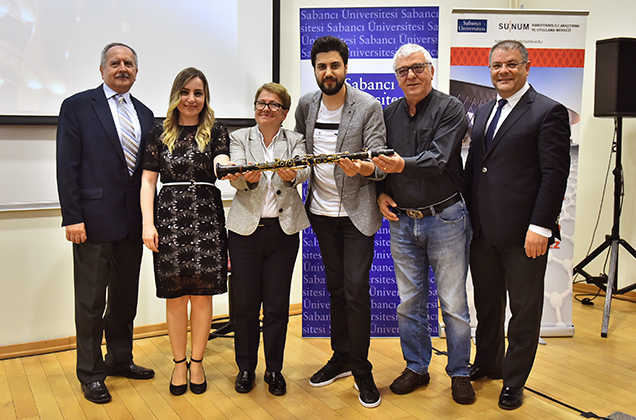29/05/2017
Sabancı University Nanotechnology Research and Application Center (SUNUM) and Akıneri Musical Instruments used graphene in a musical instrument for the first time in the world. A clarinet reinforced with graphene made by the Sabancı University affiliate NANOGRAFEN was introduced at an event held on the Sabancı University campus on Wednesday, May 24, 2017.

After introductory remarks by Sabancı University Faculty of Engineering and Natural Sciences Dean Professor Yusuf Menceloğlu, SUNUM Director Dr. Volkan Özgüz, SUNUM Researcher Assistant Professor Burcu Saner Okan and Akıneri Musical Instruments founder Aydan Akıneri spoke about the instrument. The event concluded with a clarinet recital by Serkan Çağrı.
SCIENCE MEETS ART
Introductory remarks of the event were delivered by Sabancı University Faculty of Engineering and Natural Sciences Dean Professor Yusuf Menceloğlu. Menceloğlu said that the world's first graphene-reinforced musical instrument could be called the perfect harmony of science and art. Yusuf Menceloğlu said that the project was an excellent example of how materials science is adapted and engineered to the needs of musical technology.
AMONG THE PIONEERS OF THE GLOBAL GRAPHENE MARKET
Sabancı University Nanotechnology Research and Application Center (SUNUM) Researcher Assistant Professor Burcu Saner Okan stated that graphene was the prodigal nanomaterial of the 21st century. Saying that Manchester University professors Andre Geim and Konstantin Novoselov won a Nobel Prize for Physics in 2010 for their work on graphene, Burcu Saner Okan explained that graphene offered exceptional electronic, mechanical and thermal properties due to its nano structure. Okan said that while the market for graphene-reinforced products was limited to a few products such as helmets, tennis rackets and touch-screens so far, the clarinet they developed was among the firsts. Burcu Saner Okan explained the advantages of using graphene in a clarinet: “The greatest improvement graphene brings to the clarinet is better transmission of sound. It takes much less effort to produce a notably better sound. Graphene extends the life of the instrument up to 10 years and prevents corrosion over time. While a conventional clarinet develops mildew due to the breath of the player, graphene is immune to it."
Akıneri Musical Instruments founder Aydan Akıneri said that after experimenting with carbon fiber, they decided to use graphene to make the clarinet even stronger. Akıneri said that they had noticed Sabancı University's research on graphene and contacted the university to discuss collaboration opportunities, continuing: "We achieved excellent results within just two months and finalized the product." Akıneri concluded that their collaboration with Sabancı University would continue for similar applications in other instruments.
The event ended with a short recital by clarinet player Serkan Çağrı. Serkan Çağrı said that there were sensory and structural differences between graphene-reinforced and conventional clarinets. “Both players and listeners note that the graphene-reinforced clarinet produces a brighter note while the sound of a conventional wooden clarinet is more muted. I enjoyed the vibrant tonality that the instrument had. Moreover, the instrument is stronger and less susceptible to cracking, which are obvious benefits for clarinet players. Having a clarinet crack just when you were getting used to it is a common problem musicians have. The graphene-reinforced clarinet prevents that from happening. I would like to thank both institutions for their efforts."





